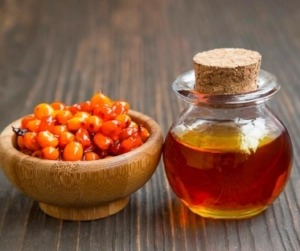Our study tested the efficacy of Omega-7 from natural sea buckthorn pulp oil in clinical burn wound healing.
The main findings are listed as follows:
- The topical application of Omega-7 increased blood flow as well as the number of blood vessels and accelerated wound healing;
- Omega-7 increased telomerase activity in burn wounds in vivo;
- Omega-7 promoted keratinocyte proliferation and migration in wound healing.
The importance of neovascularization for wound healing is well known. Treatment with Omega-7 significantly increased the number of blood vessels and blood flow in the wound beds. Sea buckthorn oil increased MMP-2 and MMP-9, which are important for neovascularization in burn wounds.
 To understand the mechanisms of increased blood flow and neovascularization, we have measured KGF and found it significantly increased by treatment with Omega-7. KGF is important during the later stages of neovascularization when luminal spaces and basement membranes are being developed. KGF is a potent mitogen for vascular endothelial cells and stimulates endothelial cells to produce a protease of urokinase-type plasminogen activator, which acts on neovascularization. In our study, Omega-7 may have increased blood flow via increasing KGF.
To understand the mechanisms of increased blood flow and neovascularization, we have measured KGF and found it significantly increased by treatment with Omega-7. KGF is important during the later stages of neovascularization when luminal spaces and basement membranes are being developed. KGF is a potent mitogen for vascular endothelial cells and stimulates endothelial cells to produce a protease of urokinase-type plasminogen activator, which acts on neovascularization. In our study, Omega-7 may have increased blood flow via increasing KGF.
Conversely, cell proliferation and migration are important for wound re-epithelialization. Our study results show that Omega-7 treatment accelerated the keratinocyte colony-forming rate and improved their migration. Various cytokines have been reported to promote keratinocyte migration. KGF plays an important role in re-epithelialization by stimulating the proliferation and migration of keratinocytes. As mentioned, the topical application of Omega-7 increased wound KGF, suggesting that Omega-7 may have also increased keratinocyte proliferation and migration and accelerated wound re-epithelialization via increasing KGF.
The present study also exhibited the topical application of Omega-7 up-regulated telomerase activity in wound keratinocytes. After cultured keratinocytes sheet grafting in burn patients, the epidermis telomere length is shortened compared to the normal epidermis in the same patient. This may be one of the mechanisms leading to long-term complications such as graft fragility or blister formation. Telomerase is activated in the epidermis as it is needed for cell proliferation and damage repair. All the results suggest that the topical application of Omega-7 may have promoted keratinocyte proliferation via increasing telomerase activity and accelerating wound re-epithelialization.
Oxidative damage is a major cause determining the rate of loss of telomeric DNA and telomere shortening. It is known that SBT reduces oxidative stress in blood cells and some organs. In the present study, we found that Omega-7 significantly reduced the wound bed 3-nitrotyrosine.
KGF is known to increase the transcription of factors involved in detoxifying oxidative stress. The previous studies strongly suggest a possible involvement of reduced oxidative stress, KGF, and telomerase activity in burn wound healing. Omega-7 may have improved wound healing by inhibiting oxidative stress and promoting KGF and telomerase activity.
The results of present and previous studies support that Omega-7 from sea buckthorn oil significantly increases the wound bed cell telomerase activity and KGF and accelerates burn wound healing, possibly by inhibiting burn-induced oxidative stress.

Leave A Comment